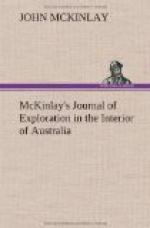Wednesday, November 6.
Wind east in gusts and cloudy; in afternoon blew strong. Temperature very agreeable.
Thursday, November 7.
Wind during the night and at daylight blew very strong from the east, towards noon it moderated; sky much clouded but I suppose up here it will all blow past without any rain, although it appears to be falling in the east. Wind round to south-east and south during afternoon with every appearance of rain.
Friday, November 8.
No rain during the night but it was very mild and close; wind south-east with a few clouds but with very little appearance of rain. Anxious to find water about a day’s stage eastward of depot; started out for that purpose east three-quarters of a mile to top of sandhill close by; then on a bearing of 118 degrees for large sandhill at quarter of a mile. Entered a well-grassed flooded flat for about two miles, and at about one and a quarter miles further arrived at sandhill. About two miles south-south-east is the grassy bed of a fine lake now dry, unless there may be a little water in the creek at the south-east end of it. Not seeing anything in the appearance of the country to indicate the presence of water on this course, I started on a bearing of 68 degrees over sandhills, and at two miles came to very cracked flooded flats, and continued on them for four and a half miles, and at one and a half miles further came to a long salty swamp running nearly north and south, a desolate spot; then a sand rise and another of the same. Changed course then to 90 degrees over sandhills; at seven miles long flooded grassed flat, north to south; then sandhill; at eight miles came to an immense flooded flat, north to south, with great width at its northern end. At two and three-quarter miles further came to top of very high sandhill, and close under (east) an immense dry salt lake or very large flat. From this there is the appearance of a large lake northward, bearing 12 degrees 20 minutes; it may be mirage, but I have observed it further back on the day’s stage, and from top of the highest hills it looks more like water than mirage, and will therefore start for it, and if I find it is water, it will suit my purpose as a stage on my intended journey to Cooper’s Creek on the arrival of the party now absent at Blanchewater. For the first three miles over sand-ridges, then over cracked flooded flats (grassless) for four miles, a box or gum creek on my right running northward and southward. At the end of this distance I am satisfied that I have been deceived; and as the day has been very hot and my horse appears to be ill I will shape my course for the camp. Started at ten minutes to 4 p.m.; find my horse thoroughly done up with, it appears, dysentery, and am obliged to camp on top of large sandhill at 6.50 p.m.; not a breath of wind and smoking hot. I chose this for a camp that I may be enabled at daylight to see if there are any waters within range of sight.




